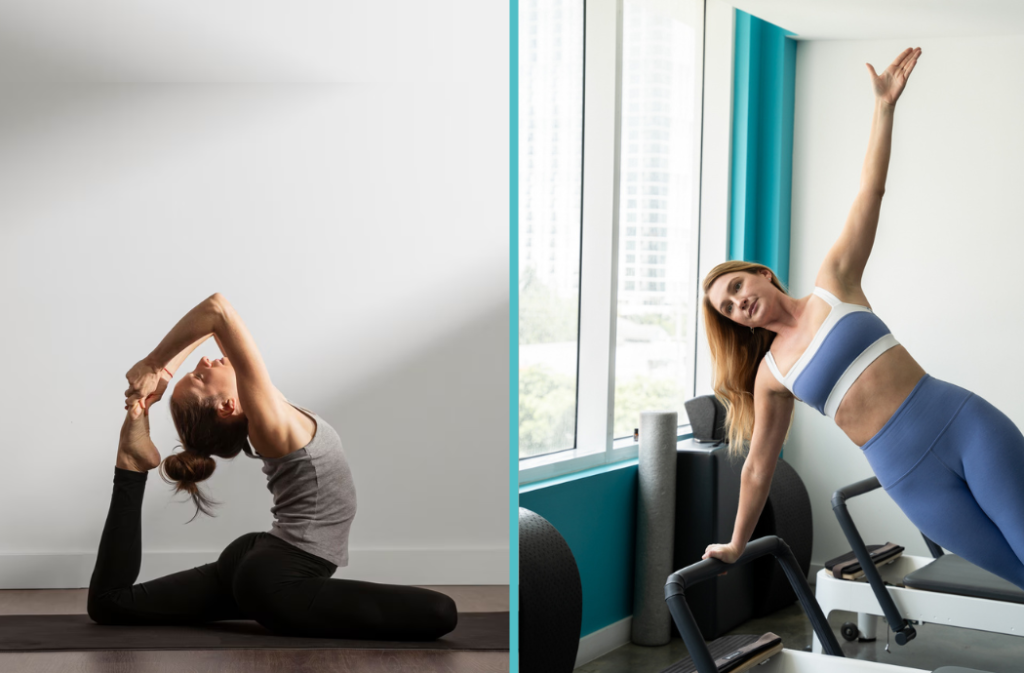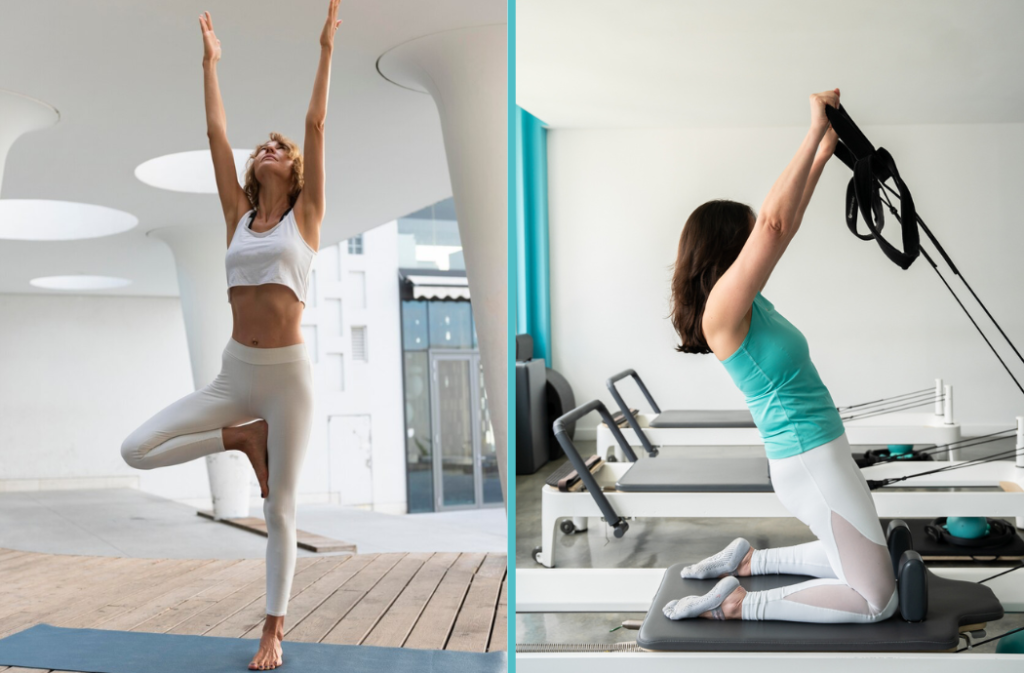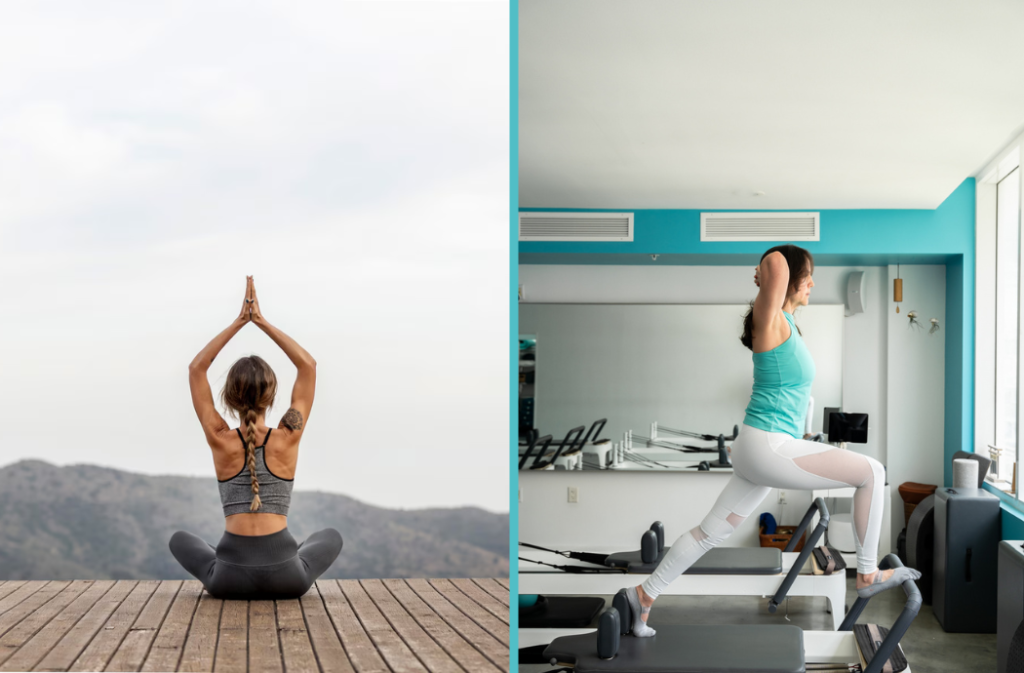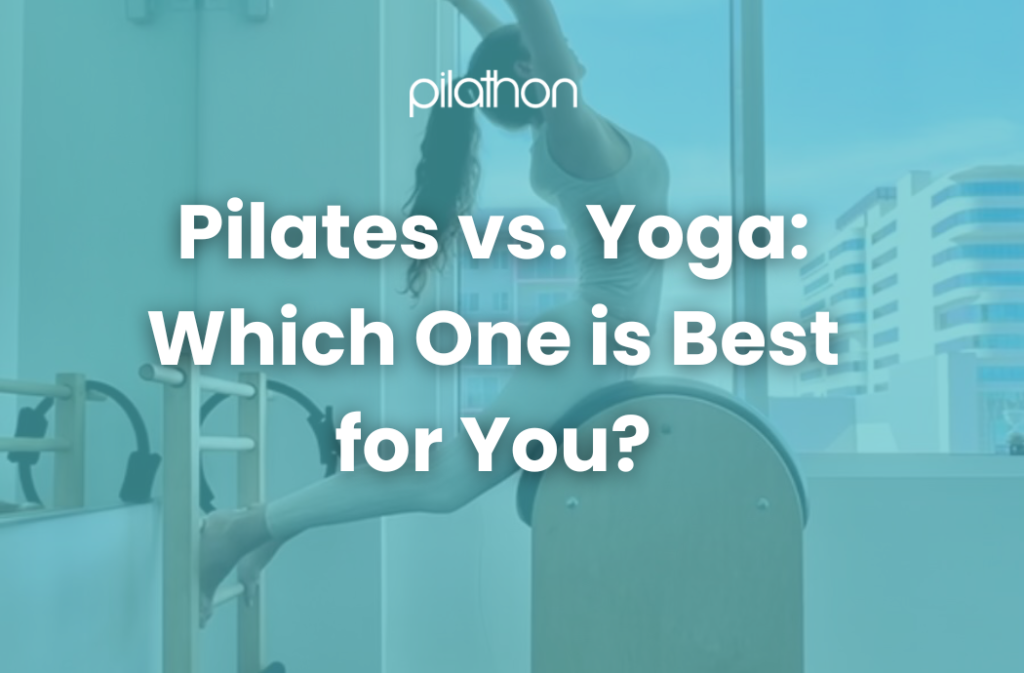In recent years, two distinct yet complementary disciplines have become widely popular: Yoga and Pilates. Both practices have captivated enthusiasts worldwide with their promises of physical strength, flexibility, and inner peace.
Yoga, with its ancient roots in spirituality and mindfulness, and Pilates, a modern system focused on core strength and alignment, offer unique pathways to achieving overall well-being.
As more individuals embrace holistic approaches to health, the choice between Yoga and Pilates becomes increasingly pertinent. Each discipline offers its own set of benefits and practices, tailored to cater to diverse fitness goals and lifestyles.
Whether you seek to improve flexibility, enhance core strength, alleviate stress, or cultivate a deeper mind-body connection, understanding the differences between Yoga and Pilates is crucial in making an informed decision that aligns with your personal objectives.
Contents on this article
Similarities Between Yoga and Pilates

Flexibility, Stretching and Mobility
Both Yoga and Pilates are renowned for their ability to enhance flexibility and promote increased range of motion:
Promotion of Flexibility:
- Yoga: Yoga incorporates a variety of stretching exercises (asanas) that target different muscle groups and joints. Poses like Downward-Facing Dog, Forward Fold, and Pigeon Pose aim to lengthen muscles and improve flexibility gradually over time.
- Pilates: Pilates exercises integrate dynamic and static stretching techniques to enhance flexibility. Movements such as the Saw, Spine Stretch Forward, and Swan Dive focus on elongating muscles while maintaining control and alignment.
Increase in Range of Motion:
- Both practices emphasize fluid movements and mindful stretching to improve joint mobility and expand range of motion.
- Enhanced flexibility and mobility achieved through Yoga and Pilates contribute to improved posture, reduced muscle tension, and increased ease in performing daily activities.
Mind-Body Connection
Yoga and Pilates are renowned for their profound emphasis on integrating mental focus with physical movement, fostering a deep mind-body connection. Here’s how both practices enhance body awareness and mindfulness:
Integration of Mental Focus and Physical Movement:
- Yoga: Rooted in ancient traditions, Yoga harmonizes breath control (pranayama), meditation, and physical postures (asanas) to synchronize mind and body. Practitioners cultivate mindfulness by focusing on the present moment during each pose, fostering a union of physical movement with inner awareness.
- Pilates: Modern Pilates principles emphasize precision and control in movement. Through deliberate exercises that engage the core and promote spinal alignment, practitioners develop heightened body awareness. This mindful approach encourages concentration on muscle engagement and alignment, integrating mental clarity with physical execution.
Enhancement of Body Awareness:
- Yoga: Yoga postures are designed to increase flexibility, strength, and balance while enhancing body awareness. Asanas are practiced with attention to alignment and breath, encouraging practitioners to listen to their bodies’ cues and respect their physical limits.
- Pilates: Central to Pilates is the concept of “centering,” focusing on core muscles as the foundation of movement. By engaging the core and practicing controlled exercises, individuals develop a keen awareness of muscle activation, posture, and movement patterns, fostering a holistic understanding of their body’s capabilities.
Core Strength
Core engagement is a fundamental aspect shared by both Yoga and Pilates, contributing to a stronger and more stable core:
Importance of Core Engagement:
- Yoga: In Yoga, core engagement is integral to maintaining stability and alignment during various poses (asanas). Poses like Plank, Boat Pose (Navasana), and Warrior III (Virabhadrasana III) require activation of the abdominal muscles to support the spine and enhance balance.
- Pilates: Pilates places a primary focus on core strength, referring to the “powerhouse” as the center of the body encompassing the abdominals, lower back, hips, and glutes. Exercises such as the Hundred, Leg Circles, and Teaser challenge the core through controlled movements, promoting stability and enhancing overall posture.
Stress Relief and Mental Well-being
Both Yoga and Pilates play significant roles in promoting stress relief and enhancing mental well-being through various techniques:
Breath Control and Relaxation:
- Yoga: Integral to Yoga practice is pranayama, or breath control techniques, which help calm the mind and reduce stress. Practices such as deep belly breathing (diaphragmatic breathing) and alternate nostril breathing (Nadi Shodhana) facilitate relaxation and promote mental clarity.
- Pilates: While less focused on breath work than Yoga, Pilates incorporates controlled breathing to enhance concentration and support movement. The emphasis on mindful breathing during exercises fosters relaxation and reduces tension, contributing to overall stress relief.
Meditative Elements:
- Yoga: Includes meditation techniques like mindfulness meditation (Vipassana) and guided imagery, which cultivate present-moment awareness and emotional balance. Meditation in Yoga encourages practitioners to observe thoughts without judgment, fostering a sense of inner peace and tranquility.
- Pilates: Although not primarily a meditative practice, Pilates encourages mindfulness through focused attention on movement and alignment. The mind-body connection inherent in Pilates exercises promotes mental clarity and helps alleviate stress by shifting focus away from daily concerns.
Low-Impact Exercises
Both Yoga and Pilates are characterized by their low-impact nature, which offers several benefits for joint health and overall mobility:
Reduced Joint Stress:
- Yoga: The gentle, controlled movements in Yoga poses help improve joint stability and flexibility without subjecting the joints to excessive stress or impact. This is particularly beneficial for individuals with joint issues or arthritis, as it supports joint health without exacerbating discomfort.
- Pilates: Similarly, Pilates exercises emphasize controlled movements that are gentle on the joints. The focus on precise alignment and core engagement minimizes strain on the joints, making it suitable for individuals recovering from injuries or seeking rehabilitation.
Improved Joint Mobility:
- Yoga: By moving through a range of poses and stretches, Yoga promotes joint mobility and flexibility.
- Pilates: Pilates exercises focus on lengthening and strengthening muscles around the joints, which supports optimal range of motion.
Suitability for Various Fitness Levels and Ages:
- Both practices are accessible to individuals of all fitness levels and ages due to their low-impact nature. Whether you are a beginner starting a fitness journey or an older adult looking to maintain mobility, Yoga and Pilates offer adaptable exercises that can be modified to suit individual needs.
Differences Between Yoga and Pilates

Origins and Philosophical Foundations
Yoga traces its roots back thousands of years to ancient India, where it originated as a spiritual practice aimed at achieving union with the divine. The exact origins of Yoga date back to the Vedas, ancient sacred texts that encompass a wide range of spiritual teachings and practices. Over millennia, Yoga evolved into various schools and traditions, each emphasizing different aspects of spiritual, mental, and physical development.
Pilates, on the other hand, was developed in the early 20th century by Joseph Pilates, a German-born fitness enthusiast and innovator. Pilates originally devised his method, initially known as Contrology, as a system of exercises to rehabilitate injured soldiers during World War I. Over time, Pilates refined his method and developed a comprehensive system of exercises that aimed to improve physical fitness, strength, and flexibility.
Primary Focus and Goals
Yoga’s primary focus is on holistic wellness, encompassing the mental, spiritual, and physical aspects of an individual’s well-being. Unlike purely physical fitness routines, Yoga integrates various practices to promote harmony and balance in all dimensions of life.
Yoga Goals:
- Mental Clarity and Emotional Balance: Yoga incorporates meditation, breathwork, and mindfulness practices to calm the mind, reduce stress, and enhance mental clarity.
- Spiritual Growth: Rooted in ancient spiritual traditions, Yoga aims to facilitate spiritual growth and self-realization.
- Physical Fitness: While spiritual and mental aspects are central, Yoga also promotes physical fitness through various Asanas (postures) that improve flexibility, strength, balance, and overall physical health.
Pilates is primarily focused on physical conditioning, emphasizing core strength, posture, and alignment. Developed as a system of exercises to rehabilitate injured soldiers, Pilates aims to improve overall physical fitness and functional movement.
Pilates Goals:
- Core Strength and Stability: Pilates exercises target the deep core muscles, including the abdominal muscles, lower back, hips, and glutes.
- Posture and Alignment: Proper alignment is crucial in Pilates, as exercises are designed to promote optimal musculoskeletal balance and efficient movement patterns.
- Functional Fitness: Beyond core strength and posture, Pilates enhances overall physical fitness by improving flexibility, coordination, and muscular endurance.
Flow and Dynamics
Yoga sessions typically begin with centering and breathing exercises, followed by warm-up poses and progressively more challenging asanas. The flow emphasizes smooth transitions between poses, linking movement with breath to create a meditative and introspective experience.
Pilates classes often start with a series of warm-up exercises focusing on core activation and spinal alignment. The flow in Pilates sessions is deliberate and controlled, with an emphasis on precision of movement and alignment. Exercises are performed with attention to proper breathing techniques and engagement of deep stabilizing muscles.
Equipment and Props
Yoga typically utilizes minimal equipment, focusing primarily on the practitioner’s body and a few basic props:
- Yoga Mats: Provide cushioning and stability during poses, enhancing comfort and preventing slipping on the floor.
- Blocks: Used to modify poses, provide support, or extend reach, helping practitioners maintain proper alignment and accessibility in postures.
- Straps: Assist in achieving deeper stretches and maintaining alignment in poses that require reaching beyond current flexibility levels.
Pilates incorporates a variety of specialized equipment in addition to mat work, designed to enhance resistance, support, and precision in movements:
- Reformers: Utilize springs and pulleys to provide variable resistance and support for exercises that strengthen muscles, improve flexibility, and promote proper alignment.
- Cadillacs (Trapeze Tables): Feature bars, straps, and springs that support a wide range of exercises targeting core strength, flexibility, and overall body conditioning.
- Stability Balls: Used to challenge balance, stability, and core strength in Pilates exercises, facilitating dynamic movements and enhancing neuromuscular coordination.
Factors to Consider When Choosing Between Yoga and Pilates

Fitness Goals
Yoga is renowned for its holistic approach to wellness, addressing not only physical fitness but also mental and spiritual well-being. It offers a comprehensive practice that integrates physical postures (asanas), breathing techniques (pranayama), and meditation.
Yoga places a strong emphasis on increasing flexibility through a variety of poses that stretch and lengthen muscles, tendons, and ligaments. Holding poses for extended periods helps improve joint mobility, reduce muscle stiffness, and enhance overall suppleness.
Pilates focuses primarily on building core strength through controlled movements that engage the deep abdominal muscles, along with muscles of the back, hips, and shoulders. This strengthens the core, improves stability, and supports better posture.
Beyond core strength, Pilates enhances overall muscle tone by targeting specific muscle groups through controlled repetitions. It promotes muscular endurance, stability, and efficient movement patterns in daily activities.
Physical Limitations and Preferences
Assessing Physical Conditions or Injuries
Yoga offers a wide range of modifications and variations that can accommodate different physical conditions or injuries. It’s often suitable for those with joint issues or flexibility concerns, as poses can be adapted to meet individual needs. However, certain styles of yoga, such as power yoga or hot yoga, may be more intense and less suitable for individuals with certain injuries or conditions.
Pilates also provides options for modifications, particularly in private or duet sessions where exercises can be tailored to address specific physical limitations or injuries. The focus on controlled movements and core strength makes it beneficial for rehabilitation and injury prevention. Pilates instructors are trained to provide adjustments that support proper alignment and reduce strain on injured areas.
Class Availability and Cost
Yoga classes are widely available in most communities, ranging from studios to gyms and community centers. The variety of classes ensures that individuals can find styles that suit their preferences, whether it’s Hatha, Vinyasa, Yin, or Bikram (hot yoga). Each style offers unique benefits, from gentle stretching and relaxation to more vigorous flows and strength-building practices.
Pilates classes are also popular and accessible, often offered in dedicated Pilates studios or integrated into fitness centers. The availability of classes may vary based on location, with urban areas typically offering more options. Pilates classes are typically categorized as mat-based or equipment-based (using machines like Reformers), each catering to different preferences and fitness levels.
Personal Interest and Enjoyment
Trying both Yoga and Pilates offers insight into each discipline’s benefits and how they align with personal preferences.
Yoga’s emphasis on holistic wellness and mind-body connection may appeal to those seeking a practice that integrates physical movement with spiritual and mental clarity.
In contrast, Pilates’ focus on building strength and improving posture through controlled movements may resonate more with individuals prioritizing physical conditioning and core stability.
Experimenting with various classes, instructors, and styles within Yoga and Pilates allows individuals to discover what feels most enjoyable and fulfilling. This exploration can lead to a deeper understanding of personal fitness goals and preferences, aiding in the decision to commit long-term to one or both disciplines.
The Bottom Line: Pilates or Yoga, Which One is Right for You?

In conclusion, Yoga and Pilates offer distinct yet complementary paths to physical and mental well-being.
- Similarities: Both disciplines emphasize mind-body connection, enhancing flexibility, promoting stress relief, and offering low-impact exercise suitable for various fitness levels.
- Differences: Yoga focuses on holistic wellness, incorporating spiritual and mental aspects alongside physical postures. In contrast, Pilates centers on physical conditioning, particularly core strength, posture improvement, and muscle tone through controlled movements and sometimes specialized equipment.
When deciding between Yoga and Pilates, it’s essential to reflect on personal fitness goals, physical needs, and lifestyle preferences.
While distinct in approach, Yoga and Pilates can complement each other:
- Incorporating both practices can enhance overall fitness by combining strength, flexibility, and mindfulness.
- Alternating between Yoga and Pilates sessions can provide a balanced fitness regimen that addresses diverse physical and mental health needs.
And if you decide Pilates is your true calling, join our Wynwood or Little River studio for the best Pilates experience in Miami!

